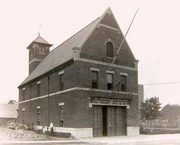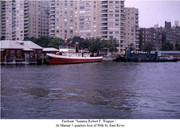Engine 66 (Marine)/Marine 6 berth - foot of Grand Street, East River, Manhattan
Engine 66 Marine organized foot Grand Street, East River 1898
Engine 66 Marine new quarters foot Grand Street, East River 1932
Engine 66 Marine new quarters foot Grand Street, East River 1941
Engine 66 Marine disbanded 1955
Marine 6 organized foot Grand Street, East River 1941
Marine 6 moved to Bldg 292 Brooklyn Navy Yard 1992
Fireboats assigned:
Engine 66 "Robert A Van Wyck" 1898
Engine 66 "William L Strong" (renamed) 1898-1938
Engine 66 "George B McClellan" 1938-1953
Marine 6 "Alfred E Smith" 1961-1992
Fireboat Van Wyck
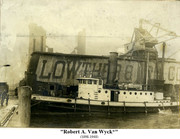
Fireboat Strong at berth:
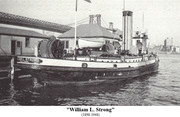
Fireboat Strong:

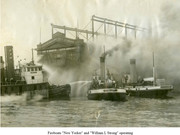
Fireboat McClellan:
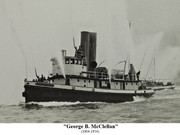
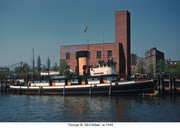
Fireboat Alfred E Smith:
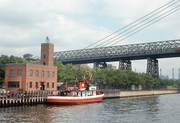
Former Engine 66/Marine 6 firehouse - today - Grand Street, East River



Corlears Point - home to pirates and hookers:
"This point of land on the East River was also called Corlaers Hook under Dutch and British rule, and briefly Crown Point during British occupation in the Revolution. It was named after the schoolmaster Jacobus van Corlaer, who settled on this "plantation" that in 1638 ... Corlaer sold the plantation to Wilhelmus Hendrickse Beekman (1623?1707) founder of the Beekman family of New York; his son Gerardus Beekman was christened at the plantation, August 17, 1653. The projection into the East River that retained Corlaer's name was an important landmark for navigators for 300 years. On older maps and documents it is usually spelled 'Corlaers' Hook, but since the early 19th century the spelling has been anglicized to Corlears. The rough unplanned settlement that developed at Corlaer's Hook under the British occupation of New York during the Revolution was separated from the densely populated city by rough hills of glacial till: "this region lay beyond the city proper, from which it was separated by high, uncultivated, and rough hills", observers recalled in 1843. As early as 1816, Corlaer's Hook was notorious for streetwalkers, "a resort for the lewd and abandoned of both sexes", and in 1821 its "streets abounding every night with preconcerted groups of thieves and prostitutes" were noted by the "Christian Herald". In the course of the 19th century they came to be called hookers. In the summer of cholera in New York, 1832, a two-story wooden workshop was commandeered to serve as a makeshift cholera hospital; between July 18 and September 15 when the hospital was closed, as the cholera wound down, 281 patients were admitted, both black and white, of whom 93 died.
The original location of Corlears Hook is now obscured by shoreline landfill. It was near the east end of the present pedestrian bridge over the FDR Drive near Cherry Street. The name is preserved in Corlear's Hook Park at the intersection of Jackson and Cherry Streets along the East River Drive." from Wikipedia
Corlears Hook history:
http://theboweryboys.blogspot.com/2009/11/corlears-hook-and-pirate-gangs-of-east.html
http://www.boweryboogie.com/2012/01/corlears-hook-and-its-hooker-history/
Corlears Hook - busy East River neighborhood of Engine 66 in early 1900s:


